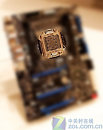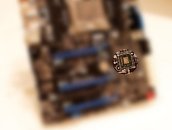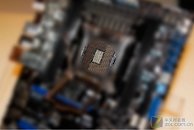Monday, January 10th 2011

Intel LGA2011 Socket, X68 Express Chipset Pictured
Here are the first pictures of Intel's new high-end CPU socket, the 2011-pin land grid array (LGA2011). A selection of pictures of an unannounced motherboard by MSI made it to the internet. LGA2011, coupled with a new chipset, the Intel X68 Express, will drive the company's new high-end and enthusiast-grade processors that feature 6, 8, or 12 cores, and quad-channel DDR3 memory controllers. At first sight, the LGA2011 is huge! Its retention clip looks to be completely detachable by unhooking the retention bars on either sides. With all LGA sockets till date, you needed to unhook one retention bar, letting you open the retention clip along a hinge.
Since the processor has four DDR3 memory channels, there's room for only one DIMM per channel on a typically-sized ATX motherboard. On this particular motherboard, we can make out that there are two DIMM slots on either sides of the socket, accommodating two channels each. With this platform, Intel transferred the northbridge component completely to the CPU package, much like LGA1156/LGA1155. Therefore, the 32-lane PCI-Express controller is housed inside the CPU package. What remains of the chipset is a PCH (platform controller hub). Like P55/H55/P67/H67, the X68 is a PCH, a glorified southbridge. It will house a smaller PCI-E hub that handles various connectivity devices, a storage controller, a LPCIO controller, USB and HDA controllers, and the DMI link to the processor. We will get to know more about this platform as the year progresses.
Source:
Zol.com.cn
Since the processor has four DDR3 memory channels, there's room for only one DIMM per channel on a typically-sized ATX motherboard. On this particular motherboard, we can make out that there are two DIMM slots on either sides of the socket, accommodating two channels each. With this platform, Intel transferred the northbridge component completely to the CPU package, much like LGA1156/LGA1155. Therefore, the 32-lane PCI-Express controller is housed inside the CPU package. What remains of the chipset is a PCH (platform controller hub). Like P55/H55/P67/H67, the X68 is a PCH, a glorified southbridge. It will house a smaller PCI-E hub that handles various connectivity devices, a storage controller, a LPCIO controller, USB and HDA controllers, and the DMI link to the processor. We will get to know more about this platform as the year progresses.



51 Comments on Intel LGA2011 Socket, X68 Express Chipset Pictured
The only reason we saw o |||| is because it was actually like this:
o - N - |||| where N is the northbridge (the memory controller).
Now that N is incorporated onto the CPU die, we can do o - |||| or || - o - ||
Now which one of the above has the shortest distance to the CPU and which one has the most consistent trace lengths? Remember that at high speeds you get all kinds of signalling problems if one memory is twice the distance from the CPU as the other. Inconsistent resistance, capacitance and crosstalk.
The second point is the internal structure of the new multi-core CPU and the internal QPI. You need to think of the memory layout as || - X - || where X is the multicore CPU, and one bank of memory is "closer" to one core and the other bank memory is closer to the other core. And the QPI deals with passing memory data from one side of the CPU to the other if necessary.
Quad-channel would be better (simpler design) in a single core system.
Dual dual-channel is better (faster) in a multi-core situation where multiple cores are working independently.
[The theoretic bandwidth of the memory is the same, but dual dual-channels can be accessing different memory locations and forwarding the data directly to different processor cores simultaneously and independently. Whereas with quad channel, latency increases when the second memory request from the second core waits for the first to be completed then forwarded by the ring bus.] *
* I put that in brackets because I'm not 100% sure of the implementation in Sandy Bridge. It might use a mixed methodology, ie. using both approaches, depending on demand. We need to know more about how those cache controllers are memory controllers have been designed.
www.bit-tech.net/news/2010/11/22/intel-z60-express-leak/1
But i would guess they are similar, X68 will have slightly higher memory bandwidth with the quad channel and slightly better pci-e performance with 2, 16x slots.
Id like to hear more about these boards, officially anyway.
._
|o|
I really look forward to seeing how the LGA2011 chips perform.I would assume it's just a coincidence kind of like the Nvidia 480 having 480 cuda cores.